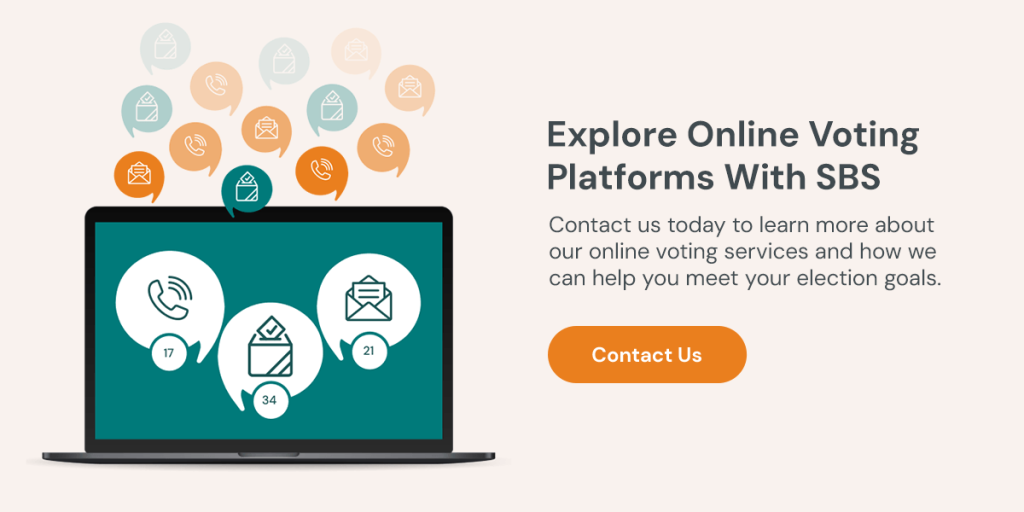Making The Shift To Online Voting
Table of Contents:
- Why Move To Online Voting Platforms?
- 5 Steps To Switch To Online Voting
- Explore Online Voting Platforms With SBS
Why Move to Online Voting Platforms?
If you’ve been uncertain about switching from paper ballots to online voting, the benefits of online voting for clubs, associations, unions, and other groups might help you decide. Paper-based voting can seem straightforward at first, but it often leads to more challenges than you expected. Here are some ways online voting platforms can improve your election process.
- Efficient voting processes: With paper voting, your team must spend considerable time designing and mailing ballots and manually counting each result. Calculating complex votes, like ranked-choice and weighted voting methods, can be time-consuming. Online voting automates these tasks while helping you avoid costs like printing and mailing individual ballots.
- Flexible voting options: Digital voting gives your members more choice. Rather than attending an event to vote in person or mailing back a ballot, they can vote whenever and wherever it’s convenient on their chosen device, such as a mobile phone, computer, or tablet. Researchers studying political elections found electronic voting could boost turnout for people who rarely or never exercise their right to vote. Speedy methods make the difference between voting and abstaining for many members.
- Improved insights: A voting platform can help you learn more about your members from their behaviors. You might analyze how members from different demographic groups prefer to vote or which candidates are popular among various groups. Tools for election analytics can help you learn and adapt to boost engagement and improve your organization.
- Reliable security: Paper ballots can introduce concerns about validity, counting errors, and duplication. A trustworthy online voting platform can eliminate these problems with tools to confirm member eligibility and protect and validate results.
If you don’t want to eliminate your paper-based voting processes, you can implement a combination approach integrating online results alongside mailed ballots and on-site voting.

5 Steps to Switch to Online Voting
Switching from paper ballots to online voting is usually straightforward for organizations that already have a system. Most of the steps involve adapting your paper system to the online platform. Other tasks include choosing your software and communicating the change to voters.
1. Get Organized
Start by gathering a list of all your eligible voters and their information. Get contact details, like their names, email addresses, and phone numbers, along with supporting details like the subgroup or chapter they belong to. You’ll need this list to:
- Get ballots to the appropriate people.
- Improve insights, such as voter participation and turnout.
- Ensure voting security by preventing duplicate or missed ballots.
Your planning stage should also include a timeline. Online voting offers much more timing flexibility, as you can hold elections over a few weeks, days, or hours. Determine when you will send ballots, the period for voting, and the dates for announcing the results. If your election includes other votes, like primary or qualifying elections, plan for these timelines, too.
2. Find the Right Platform
The success of digital voting hinges on your online platform. You have several options, and finding one that works for your organization is crucial. Some offer more features and different methods for collecting votes.
Before choosing a platform, consider how you want to implement it. At Survey and Ballot Systems (SBS), we offer three models for online voting setup.
- Fully managed services: A fully managed election partner provides turnkey services to take care of the entire process for you, including complex and hybrid voting and a custom voting website. Fully managed online voting is an excellent choice if you’re short on time, want to distance your administrators from the voting process, or need more support from an experienced team.
- DIY online elections: The DIY approach lets you use an intuitive, cloud-based platform to run elections with 5,000 voters or fewer. You’ll choose your time frame and customize your election site and emails.
- Real-time voting software: Consider real-time voting software to hold elections during meetings and other live events. This option is also cloud-based, and your voters can access it through their mobile devices. You can update your ballot in real time with drag-and-drop tools, share documents, provide post-meeting emails, and access other helpful tools.
Consider additional tools you may want as you choose your platform, like election analytics, strong security practices, voting reminders and single sign-on options.
3. Set up Your New Platform
With your platform chosen, you can set up your election. Work with a fully managed provider to give them any necessary information, or build your ballot yourself.
Your election partner should make online voting setup seamless. At SBS, our platform’s interface is intuitive and user-friendly. Our expert team members can help at every step to support a simple, enjoyable election and increased engagement. We pair you with a dedicated team specifically for your project, so when you call, you can talk to someone familiar with your organization and goals. Simple, tailored setup lets your team focus on mission-critical tasks instead of creating and mailing ballots.
4. Keep Voters in the Loop
Voters will need to know how your new process works. Include instructions either before or when sending out the ballots. For example, you could email a link to an instructional video on completing online voting, from signing up or accessing a ballot to casting a vote. You can also share informational content about online voting, such as its security and reliability, to build confidence and trust. SBS offers many resources to benefit your voters.
Are you sending physical ballots or fliers? You can even print a scannable QR code on your mailers to make accessing ballots as simple as possible.
Digital voting is also an excellent way to incorporate elections in online communications. Since voters can access it via a link or code, you can easily promote the election through text messages, social media, emails, and other digital channels. A simple reminder at the bottom of a social media post can improve turnout. If you have a marketing or PR team, connect with them to increase your reach effectively.
5. Conduct Online Voting and Review the Results
With everything in place, you can start your online election. Sit back and let your system do the work, or play an active role by monitoring results or making real-time adjustments.
When the election closes, allow your software to calculate results. Use additional information to learn more about your members and elections, such as who participated. Figure out how you can turn this data into action. For instance, you might build a more robust email campaign for the next election if you learn most of your votes came from an email reminder.
Now, all that’s left is to announce your winners.
Explore Online Voting Platforms With SBS
Whether you manage elections for a small club, a large international association, or something in between, the switch to online voting can modernize and streamline your processes. A trusted partner simplifies building and running elections with robust, secure tools.
SBS has decades of expertise in online voting and a commitment to quality. We help some of the world’s top organizations conduct online elections securely and customize the member experience. Contact us today to learn more about our online voting services and how we can help you meet your election goals.

